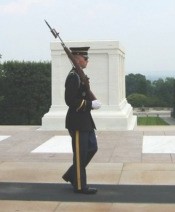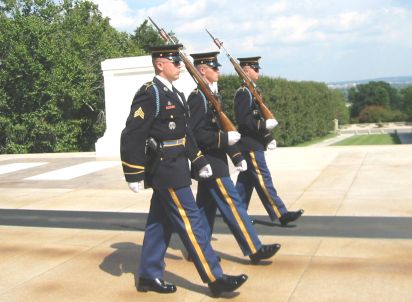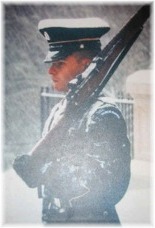It
was my second visit to the hallowed grounds of
Arlington National Cemetery, the first being nearly twenty years
earlier when my oldest son was a member of the 1st Battalion, Third U.
S. Infantry (The Old Guard). He was assigned to Presidential
Honor Guard, and his duty station was the White House. He was
proud of his membership in that elite group and especially his company,
which also included the young men who guard the Tomb of the Unknown
Soldiers and the U.S. Army Drill Team. He took me there, and
I watched the complete tour of a tomb sentinel. (They prefer
being called sentinels, rather than guards.) I have it all on
8mm film, which I rarely see. On this visit, I had my new
digital camera, and wanted still pictures to add to the chronicles of
my extended stay in Washington, D. C. I have cherished the
memories of that first visit, remembering this mother's extreme pride
in her son.
 Today was
different. I was
alone on a sultry, nearly 100-degree day, with humidity to
match. The only sounds I heard were those of the buzzing
locusts, and the call of an occasional bird. From the parking
lot, I approached the intersection of Eisenhower Drive and Roosevelt
Avenue. The long walkway is steep, and the effort was extreme
for me. The number of gravesites now has reached more than
270,000, and which includes the family members of America's honored
warriors. The sight of so many graves demands one's silence
and reflection. The cemetery is comprised of hills, trees,
and lawns, and is immaculately groomed. I pass a grave whose
stone is topped with several small pebbles, placed there by visiting
family members; one for each relative. I passed the entrance
to John F. Kennedy's gravesite, and continued to the entrance of the
area that contains the tomb memorial. There is a circular
courtyard at that Roosevelt Avenue entrance, with simple beds of pink
begonias and several benches offered to a weary walker under the shade
of many large, heavily canopied trees. I sat and rested for a
few minutes, with a huge bumblebee as my only companion. Today was
different. I was
alone on a sultry, nearly 100-degree day, with humidity to
match. The only sounds I heard were those of the buzzing
locusts, and the call of an occasional bird. From the parking
lot, I approached the intersection of Eisenhower Drive and Roosevelt
Avenue. The long walkway is steep, and the effort was extreme
for me. The number of gravesites now has reached more than
270,000, and which includes the family members of America's honored
warriors. The sight of so many graves demands one's silence
and reflection. The cemetery is comprised of hills, trees,
and lawns, and is immaculately groomed. I pass a grave whose
stone is topped with several small pebbles, placed there by visiting
family members; one for each relative. I passed the entrance
to John F. Kennedy's gravesite, and continued to the entrance of the
area that contains the tomb memorial. There is a circular
courtyard at that Roosevelt Avenue entrance, with simple beds of pink
begonias and several benches offered to a weary walker under the shade
of many large, heavily canopied trees. I sat and rested for a
few minutes, with a huge bumblebee as my only companion.
As
I approached the ceremonial area where the three soldiers lay, a new
guard was installed to begin his duty. I climbed about half
way up the stairs, and made my way back down to the center
front. There were few visitors, this being such a hot
day. I simply sat and watched this young solder, resplendent
in Army Blues, march his assigned territory on the black rubber
mat. The only sound he made was when he clicked his heels
sharply together at the beginning of his turn, and the sound of the
presentation of his rifle at each end of the mat. There were
no sounds whatsoever from the visitors. Each turn he made was
as crisp and as sharp as the bayonet fixed to the end of his
rifle. His shoes are custom made, at his own expense, with
very thick soles, in order to hold the large steel taps. As
he steps, his foot hits the mat with heels first, then rolls to the
outside edge of his foot, and then rolling onto the ball of his
foot. This special gait is the gait of all the soldiers who
drill in ceremony. It provides a smooth grace reminiscent of
a dancer, forcing his body to move in a perfectly straight line, with
no vertical movement. I think to myself that they must have
very strong feet and ankles.
The
heat and humidity emanate from the white marble in waves. It
is hard to even breathe. There are brown lines, with wider spots
interspersed along them, beside the mat. I later realized
that the lines are the tiny imbedded particles of the shoes that have
performed this march tens of thousands of times.  The wide
spots mark the area where a turn is made, and one can map the ceremony
of the changing of the guard by them. Every soldier who has
ever marched there leaves a bit of himself behind in the marble, to be
forever as entombed as the honored heroes. It is a right and
fitting memorial to the young men who have served so
eloquently. You have to understand that the
sentinel is there because of his pride in his service, and dedication
to his duty and his duty is a difficult one. Before he begins
his watch, his fellow guards carefully dress him. His company and his
audience rigidly scrutinize his appearance and demeanor. The wide
spots mark the area where a turn is made, and one can map the ceremony
of the changing of the guard by them. Every soldier who has
ever marched there leaves a bit of himself behind in the marble, to be
forever as entombed as the honored heroes. It is a right and
fitting memorial to the young men who have served so
eloquently. You have to understand that the
sentinel is there because of his pride in his service, and dedication
to his duty and his duty is a difficult one. Before he begins
his watch, his fellow guards carefully dress him. His company and his
audience rigidly scrutinize his appearance and demeanor.
The
tomb is never left unguarded at any time, 24 hours a day, and 365 days
a year. These young men have to endure every extreme of
nature that exists. His only concentration is the focus of
his watch. His eyes never recognize anything but the job at
hand. Stand at one end of the mat for
exactly 21 seconds. March 21 steps to the other end of the mat, click
heels, turn 90 degrees, stand for 21 seconds, turn again, present the
rifle, and stand again for 21 seconds. March 21 steps back to the other
end of the mat. Repeat the above over and over until the end
of the watch. It takes dedication to perform this honor for
the dead that lie beside his mat, just in front of the memorial whose
simple inscription reads, "Here Rests in Honored Glory An American
Soldier Known But to God."
Only God may know the
identity of the soldier, but the soldier on duty knows the soldier who
is honored, for he is one of them. That is why he is there.  | The
Sentinel's Creed:
My dedication to this
sacred duty
Is total and wholehearted.
In the
responsibility bestowed on me
Never will I falter.
And
with dignity and perseverance
My standard will remain
perfection.
Through the years of diligence and praise
And
the discomfort of the elements,
I will walk my tour in humble
reverence
To the best of my ability.
It is he who
commands the respect I protect,
His bravery that made us so
proud.
Surrounded by well meaning crowds by day,
Alone
in the thoughtful peace of night,
This soldier will in
honored glory rest
Under my eternal vigilance. |
|
 Today was
different. I was
alone on a sultry, nearly 100-degree day, with humidity to
match. The only sounds I heard were those of the buzzing
locusts, and the call of an occasional bird. From the parking
lot, I approached the intersection of Eisenhower Drive and Roosevelt
Avenue. The long walkway is steep, and the effort was extreme
for me. The number of gravesites now has reached more than
270,000, and which includes the family members of America's honored
warriors. The sight of so many graves demands one's silence
and reflection. The cemetery is comprised of hills, trees,
and lawns, and is immaculately groomed. I pass a grave whose
stone is topped with several small pebbles, placed there by visiting
family members; one for each relative. I passed the entrance
to John F. Kennedy's gravesite, and continued to the entrance of the
area that contains the tomb memorial. There is a circular
courtyard at that Roosevelt Avenue entrance, with simple beds of pink
begonias and several benches offered to a weary walker under the shade
of many large, heavily canopied trees. I sat and rested for a
few minutes, with a huge bumblebee as my only companion.
Today was
different. I was
alone on a sultry, nearly 100-degree day, with humidity to
match. The only sounds I heard were those of the buzzing
locusts, and the call of an occasional bird. From the parking
lot, I approached the intersection of Eisenhower Drive and Roosevelt
Avenue. The long walkway is steep, and the effort was extreme
for me. The number of gravesites now has reached more than
270,000, and which includes the family members of America's honored
warriors. The sight of so many graves demands one's silence
and reflection. The cemetery is comprised of hills, trees,
and lawns, and is immaculately groomed. I pass a grave whose
stone is topped with several small pebbles, placed there by visiting
family members; one for each relative. I passed the entrance
to John F. Kennedy's gravesite, and continued to the entrance of the
area that contains the tomb memorial. There is a circular
courtyard at that Roosevelt Avenue entrance, with simple beds of pink
begonias and several benches offered to a weary walker under the shade
of many large, heavily canopied trees. I sat and rested for a
few minutes, with a huge bumblebee as my only companion. The wide
spots mark the area where a turn is made, and one can map the ceremony
of the changing of the guard by them. Every soldier who has
ever marched there leaves a bit of himself behind in the marble, to be
forever as entombed as the honored heroes. It is a right and
fitting memorial to the young men who have served so
eloquently. You have to understand that the
sentinel is there because of his pride in his service, and dedication
to his duty and his duty is a difficult one. Before he begins
his watch, his fellow guards carefully dress him. His company and his
audience rigidly scrutinize his appearance and demeanor.
The wide
spots mark the area where a turn is made, and one can map the ceremony
of the changing of the guard by them. Every soldier who has
ever marched there leaves a bit of himself behind in the marble, to be
forever as entombed as the honored heroes. It is a right and
fitting memorial to the young men who have served so
eloquently. You have to understand that the
sentinel is there because of his pride in his service, and dedication
to his duty and his duty is a difficult one. Before he begins
his watch, his fellow guards carefully dress him. His company and his
audience rigidly scrutinize his appearance and demeanor.